Monthly Archives: September 2019
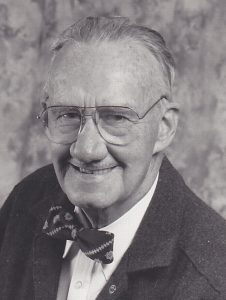 I am amazed at the number of inventions that have changed our world, but when they were invented, they were not what the inventor was trying to invent. Basically, while trying to make one thing, or repair something, the inventor stumbled on something else, and made an important discovery. Wilson Greatbatch was an inventor who had been quite successful, having 150 patents to his credit at the time of his accidental invention. Overall, in his lifetime, he was credited with an astonishing total of 325 patents for his many great brainstorms. Patents aside, Greatbatch will be best remembered for the invention and development of the first implantable pacemaker, a device which has improved, saved, and extended countless lives since its first use in 1960. Worldwide, approximately three million people currently benefit from Greatbatch’s discovery, with an additional 600,000 being implanted every year. It was not what he had be trying to make, however.
I am amazed at the number of inventions that have changed our world, but when they were invented, they were not what the inventor was trying to invent. Basically, while trying to make one thing, or repair something, the inventor stumbled on something else, and made an important discovery. Wilson Greatbatch was an inventor who had been quite successful, having 150 patents to his credit at the time of his accidental invention. Overall, in his lifetime, he was credited with an astonishing total of 325 patents for his many great brainstorms. Patents aside, Greatbatch will be best remembered for the invention and development of the first implantable pacemaker, a device which has improved, saved, and extended countless lives since its first use in 1960. Worldwide, approximately three million people currently benefit from Greatbatch’s discovery, with an additional 600,000 being implanted every year. It was not what he had be trying to make, however.
Wilson Greatbatch was born the son of British immigrants, Warren and Charlotte Greatbatch, in Buffalo, New York, in 1919. He attended school at West Seneca, New York. He had many interests, among which were the sea scouts and amateur radio. Greatbatch was just 16 years old when he received his amateur radio license. During World War II, Greatbatch served in the US Navy as an aviation chief radioman. He took advantage of the 1944 GI Bill to attend Cornell University, where he studied electrical engineering. He graduated in 1950 and began a teaching career at the University of Buffalo in 1952.
It was in 1956, while working at Buffalo, that he made his most important discovery. While it was his most important discovery, it was also the result of an error. Greatbatch had been working on a heart-rhythm recorder, but he mistakenly added an incorrect electronic component. The resulting device produced electrical pulses, instead of simply recording the rhythm. Recalling the event later, he said “I stared at the thing in  disbelief.” Greatbatch realized immediately that he had found a way to electrically simulate and stimulate a heartbeat. It was to become the most important invention of his life, and one that millions of people would be eternally grateful to him for “stumbling upon.”
disbelief.” Greatbatch realized immediately that he had found a way to electrically simulate and stimulate a heartbeat. It was to become the most important invention of his life, and one that millions of people would be eternally grateful to him for “stumbling upon.”
Of course, Greatbatch didn’t make the first pacemaker, but the prior models were bulky, external units which required the use of mains power, basically they had to be plugged into the wall…not conducive to leading an active life. At that time, battery technology was not advanced enough to allow the earlier units to be implanted, and my guess is that they were also big and bulky. Over the following two years Greatbatch managed to miniaturize and package the device so that it could be implanted. In May of 1958, he gave a successful demonstration of the invention in a dog. By 1960 the pacemaker had been implanted in the first human patient, a 77 year old man, who went on to live for another 18 months…not bad for a 77 year old heart patient.
A patent for the implantable pacemaker was granted in 1962, and in 1970 Greatbatch founded Wilson Greatbatch Ltd, which was later renamed now Greatbatch Inc, a company which continues to develop and manufacture lithium-based batteries for pacemakers. Greatbatch himself however, despite now having extensive offices and laboratory facilities, preferred to continue his research at his home garage workshop. He was always a tinkerer, and as he said in an interview with the Associated Press, “Nine things out of 10 don’t work, but the 10th one will pay for the other nine”. When he was asked about the change in quality of life that the pacemaker brought, Greatbatch told his local Buffalo newspaper in 1984, “I think one of my first and most gratifying realizations of what a pacemaker could do was in observing the reactions of elderly people to their grandchildren. People with heart disease generally don’t have enough blood supply to their brains and couldn’t respond before to the bantering of kids.”
Greatbatch was presented with many awards during his lifetime. In 1983 the National Society of Professional 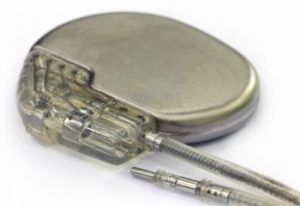 Engineers selected the pacemaker as one of the greatest contributions to society of the previous 50 years. In 1998 Greatbatch was inducted into the National Inventors’ Hall of Fame in Akron, Ohio, alongside his hero Thomas Edison. This was followed, in 2001, by the granting of the highest honor from the National Academy of Engineering, shared with his peer Earl Bakken, who invented the external pacemaker. Greatbatch’s autobiographical account of his discovery, The Making of the Pacemaker: Celebrating a Lifesaving Invention, was published in 2000. Wilson Greatbatch died at the good old age of 92 on September 27, 2011. Greatbatch served as an elder at Clarence Presbyterian Church, where he also sang in the church choir and taught Sunday school.
Engineers selected the pacemaker as one of the greatest contributions to society of the previous 50 years. In 1998 Greatbatch was inducted into the National Inventors’ Hall of Fame in Akron, Ohio, alongside his hero Thomas Edison. This was followed, in 2001, by the granting of the highest honor from the National Academy of Engineering, shared with his peer Earl Bakken, who invented the external pacemaker. Greatbatch’s autobiographical account of his discovery, The Making of the Pacemaker: Celebrating a Lifesaving Invention, was published in 2000. Wilson Greatbatch died at the good old age of 92 on September 27, 2011. Greatbatch served as an elder at Clarence Presbyterian Church, where he also sang in the church choir and taught Sunday school.
 Every time I learn anything about Adolf Hitler, I am stunned that so much evil could exist in one man. World War II technically started when Adolf Hitler invaded Poland. Hitler told his men that “it did not matter who was right or wrong, that in fighting a war, coming out triumphant is the only thing that counted.” He urged his men to have no sympathy for their opponent. On September 1, 1939, Hitler ordered the invasion of Poland, by ordering the attack of defenseless civilians. In this way, they put the citizens in a state of shock. The sky was dark and there were dead bodies everywhere. Once Germany invaded Poland, it opened a door to allow the Soviets to also invade Poland. Of course, this was not exactly what either country wanted.
Every time I learn anything about Adolf Hitler, I am stunned that so much evil could exist in one man. World War II technically started when Adolf Hitler invaded Poland. Hitler told his men that “it did not matter who was right or wrong, that in fighting a war, coming out triumphant is the only thing that counted.” He urged his men to have no sympathy for their opponent. On September 1, 1939, Hitler ordered the invasion of Poland, by ordering the attack of defenseless civilians. In this way, they put the citizens in a state of shock. The sky was dark and there were dead bodies everywhere. Once Germany invaded Poland, it opened a door to allow the Soviets to also invade Poland. Of course, this was not exactly what either country wanted.
Before the end of the month, on September 29, 1939, Germany and the Soviet Union agree to divide control of occupied Poland roughly along the Bug River, with the Germans taking everything west, and the Soviets taking everything east. The people of Poland were given away like slaves. In addition, as a follow-up to the Molotov-Ribbentrop Pact, which was also known as the Hitler-Stalin Pact, a non-aggression treaty was created between the two huge military powers of Germany and the USSR. The German foreign minister, Joachim von Ribbentrop met with his Soviet counterpart, VM Molotov, to sign the German-Soviet Boundary and Friendship Treaty. Of course, the “friendship” did not extend to the Polish people.
As in normal in any contract, there was “fine print” in this agreement too. The fine print of the original non-aggression pact had promised the Soviets a slice of eastern Poland. It was to be a small part, simply a matter of agreeing where to draw the lines. Joseph Stalin, Soviet premier and dictator, personally drew the line that partitioned Poland. He originally wanted it drawn at the River Vistula, just west of Warsaw. In the end, he agreed to pull it back east of the capital and Lublin, giving Germany control of most of Poland’s most heavily populated and industrialized regions. In exchange, Stalin wanted Lvov, and its rich oil wells, and Lithuania, which sits atop East Prussia. Germany was fine with that, because now they had 22 million Poles, “slaves of the Greater German Empire,” at its disposal…and Russia had a western buffer zone.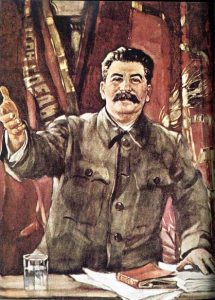
On this same day, the Soviet Union also signed a Treaty of Mutual Assistance with the Baltic nation of Estonia, giving Stalin the right to occupy Estonian naval and air bases. What was thought to be a buffer zone, seems more like a land grab to me. A similar treaty would later be signed with Latvia. These nations really didn’t seem to realize what they were getting into. Eventually, Soviet tanks rolled across these borders, in the name of “mutual assistance,” placing the Baltic States under the rule of the USSR for decades to come. These so called treaties were once again merely the realization of more fine print from the Ribbentrop-Molotov Pact, giving Stalin more border states as buffer zones, and protecting Russian territory where the Bolshevik ideology had not been enthusiastically embraced from intrusion by its western neighbor, namely its non-aggression partner Germany. The highly vulnerable Baltic nations had no say in any of these arrangements. They were merely annexed…by force in a huge Soviet land grab.
 Born Jewish, on April 4, 1922, in Berlin, Germany, did not necessarily set Marie Jalowicz up for a long carefree life. Marie was 11 years old when the Nazi Party came to power, and soon after began to imprison her family members. By age 20, Marie was forced to fend for herself. She found herself faced with the difficult task of constantly avoiding the Nazis. For Marie, this meant somehow assimilating into German life…basically pretending to be a non-Jew. I can’t imagine having to pretend to be a nationality other than my own, but that is what she had to do. Anything about her that was Jewish had to be set aside, forgotten, or hidden from the eyes and ears of the Nazis, who seemed to be everywhere around her.
Born Jewish, on April 4, 1922, in Berlin, Germany, did not necessarily set Marie Jalowicz up for a long carefree life. Marie was 11 years old when the Nazi Party came to power, and soon after began to imprison her family members. By age 20, Marie was forced to fend for herself. She found herself faced with the difficult task of constantly avoiding the Nazis. For Marie, this meant somehow assimilating into German life…basically pretending to be a non-Jew. I can’t imagine having to pretend to be a nationality other than my own, but that is what she had to do. Anything about her that was Jewish had to be set aside, forgotten, or hidden from the eyes and ears of the Nazis, who seemed to be everywhere around her.
Marie knew that as the situation for Jews in Nazi Germany deteriorated, things would grow steadily worse for her. She had to somehow come up with a way to virtually hide in plain sight. When a postman wrongly delivered a letter for a job offer intended for the neighbor in 1941, she told a postman that her “neighbor” Marie was taken by the Nazis, then she simply started walking around without a star on her jacket. She was successfully living under a false identity. She took the job and began  working at the Siemens arms factory in her neighbor’s place. While living this double life, Jalowicz sabotaged production at the arms factory where she worked. Marie evaded Nazi capture through a long string of forgeries, impersonations, and help from people from every walk of life. Marie became Johanna Koch, using her wit and charm to seduce people in positions that could help her and moved around constantly. She took the words of a friend of hers to heart, “In absurd times, everything is absurd. You can save yourselves only by absurd means since the Nazis are out to murder us all.” On more than one occasion she tried to flee Germany, narrowly evading apprehension and escaping back to her homeland each time. She relocated often, and at one point was sold to an abusive Nazi with late-stage syphilis for 15 marks, which added to her cover as a non-Jew. In the coming years, she took menial jobs and lived in several Berlin flats, at times with roommates who were fervent Nazis. I can’t imagine how awful it was for her.
working at the Siemens arms factory in her neighbor’s place. While living this double life, Jalowicz sabotaged production at the arms factory where she worked. Marie evaded Nazi capture through a long string of forgeries, impersonations, and help from people from every walk of life. Marie became Johanna Koch, using her wit and charm to seduce people in positions that could help her and moved around constantly. She took the words of a friend of hers to heart, “In absurd times, everything is absurd. You can save yourselves only by absurd means since the Nazis are out to murder us all.” On more than one occasion she tried to flee Germany, narrowly evading apprehension and escaping back to her homeland each time. She relocated often, and at one point was sold to an abusive Nazi with late-stage syphilis for 15 marks, which added to her cover as a non-Jew. In the coming years, she took menial jobs and lived in several Berlin flats, at times with roommates who were fervent Nazis. I can’t imagine how awful it was for her.
Marie went on to become a German philologist and historian of philosophy, pursued a career in academia, 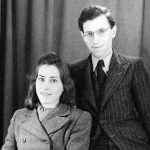 and received a Ph.D. in ancient literature and art history at Berlin’s Humboldt University. Then, after the war, she become a professor at Humboldt University, where she worked until her death in 1998. Just before her death she recorded 77 cassette tapes of audio with her son, Hermann. In the tapes, for the first time, Marie chronicled her experience during the Nazi reign. They were later compiled into a book called, Underground in Berlin: A Young Woman’s Extraordinary Tale of Survival in the Heart of Nazi Germany. She became known to larger audiences for this, her autobiographical account of the persecution of Jews in Nazi Germany, which was published posthumously. Marie died on September 16, 1998. She returned to her original identity only on her deathbed. Her mother died of cancer in 1938. Her father died in 1941. She is survived by her only son, Hermann Simon.
and received a Ph.D. in ancient literature and art history at Berlin’s Humboldt University. Then, after the war, she become a professor at Humboldt University, where she worked until her death in 1998. Just before her death she recorded 77 cassette tapes of audio with her son, Hermann. In the tapes, for the first time, Marie chronicled her experience during the Nazi reign. They were later compiled into a book called, Underground in Berlin: A Young Woman’s Extraordinary Tale of Survival in the Heart of Nazi Germany. She became known to larger audiences for this, her autobiographical account of the persecution of Jews in Nazi Germany, which was published posthumously. Marie died on September 16, 1998. She returned to her original identity only on her deathbed. Her mother died of cancer in 1938. Her father died in 1941. She is survived by her only son, Hermann Simon.
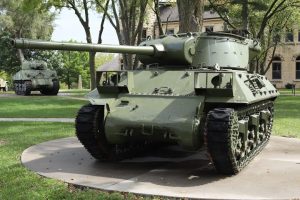 After World War II, the GIs who had fought in the war, came home, eager to start their lives over. Many went to the car dealerships to buy new cars, only to find that there were no new cars to be found. What a bizarre thought!! In my entire lifetime, I don’t know of a time that new cars weren’t available, but there was a reason for the lack of new cars.
After World War II, the GIs who had fought in the war, came home, eager to start their lives over. Many went to the car dealerships to buy new cars, only to find that there were no new cars to be found. What a bizarre thought!! In my entire lifetime, I don’t know of a time that new cars weren’t available, but there was a reason for the lack of new cars.
During World War II, the whole United States “kicked in” on the war effort. The automobile industry changed the production in their factories from automobiles to whatever was needed for the war effort. The United States automakers manufactured a wide variety of vehicles, munitions, and more 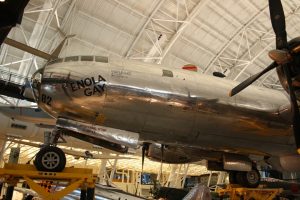 for the government. They made tanks like the Fisher Body Grand Blanc, the Ford M10 Wolverine, and the M18 Hellcat, which were produced by the Buick Motor Car Division of General Motors. Some of the automakers were tasked with producing parts for planes, including the infamous Enola Gay. The 18-foot nose section of the fuselage was built by Chrysler. Chevrolet alone produced 60,000 engines for Pratt and Whitney cargo and bomber planes between 1942 and 1945, along with 500,000 trucks, 8 million artillery shells, and much more. The tire company, Firestone Tire and Rubber Company produced the 40 mm cannon gun mount one of which was placed on the deck of the USS Cod, while another was mounted on the
for the government. They made tanks like the Fisher Body Grand Blanc, the Ford M10 Wolverine, and the M18 Hellcat, which were produced by the Buick Motor Car Division of General Motors. Some of the automakers were tasked with producing parts for planes, including the infamous Enola Gay. The 18-foot nose section of the fuselage was built by Chrysler. Chevrolet alone produced 60,000 engines for Pratt and Whitney cargo and bomber planes between 1942 and 1945, along with 500,000 trucks, 8 million artillery shells, and much more. The tire company, Firestone Tire and Rubber Company produced the 40 mm cannon gun mount one of which was placed on the deck of the USS Cod, while another was mounted on the 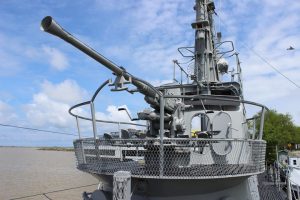 stern of PT-305. Pontiac Motor Car Division built aerial launched torpedoes at its facilities in Pontiac, Michigan.
stern of PT-305. Pontiac Motor Car Division built aerial launched torpedoes at its facilities in Pontiac, Michigan.
By the time the World War II ended in 1945, the total value of goods produced by the United States auto industry for the war would exceed $29 million, equal to nearly $400,000,000 today. There had been no new cars built in the United States between early 1942 and late 1945. Once the war was over, automakers were again free to begin manufacturing new cars for the American public. That was all well and good, but it would take time to bring production of automobiles back up to speed. The first car built for civilian sale after World War II, was a Super Deluxe Ford. It rolled off the assembly line on July 3, 1945.
 I think most people have played with a Slinky at one point or another in their lives. The Slinky is a pre-compressed helical spring toy invented by Richard James in the early 1940s. It is able to perform a number of tricks, including travelling down a flight of steps end-over-end as it stretches and re-forms itself with the aid of gravity and its own momentum, or appear to levitate for a period of time after it has been dropped. Kids have been known to spend hours playing with the simple spring, which rather defies the imagination in itself. Most kids tire easily of toys, so the long lasting play with a slinky was surprising. Still, as with all such toys, the Slinky eventually lost its draw, and few people play with it now.
I think most people have played with a Slinky at one point or another in their lives. The Slinky is a pre-compressed helical spring toy invented by Richard James in the early 1940s. It is able to perform a number of tricks, including travelling down a flight of steps end-over-end as it stretches and re-forms itself with the aid of gravity and its own momentum, or appear to levitate for a period of time after it has been dropped. Kids have been known to spend hours playing with the simple spring, which rather defies the imagination in itself. Most kids tire easily of toys, so the long lasting play with a slinky was surprising. Still, as with all such toys, the Slinky eventually lost its draw, and few people play with it now.
The strangest thing about the Slinky is that it wasn’t invented to be a toy at all. In 1943, a naval mechanical 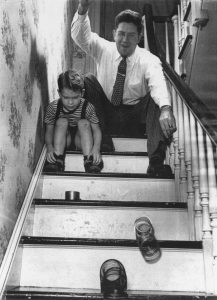 engineer named Richard James, who was stationed at the William Cramp and Sons shipyards in Philadelphia, was developing springs that could support and stabilize sensitive instruments aboard ships in rough seas. As he worked, James accidentally knocked one of the springs from a shelf, and watched as the spring “stepped” in a series of arcs to a stack of books, to a tabletop, and to the floor, where it re-coiled itself and stood upright. I’m sure the sight was funny, mostly because it was so unexpected. As his wife Betty later recalled, “He came home and said, ‘I think if I got the right property of steel and the right tension; I could make it walk.'” As with any inventor, I’m sure that his inventor’s mind was already clicking. James began to experiment with different types of steel wire over the next year, and finally found a spring that would walk. I’m sure he was like “a kid in a candy store” with each fine-tuning of the toy. Betty was skeptical at first, but changed her mind after the toy was fine-tuned and neighborhood children expressed an excited interest in it. She dubbed the toy Slinky, by which she meant “sleek and graceful,” after finding the word in a dictionary, Betty decided that this word exactly described the sound of a metal spring expanding and collapsing.
engineer named Richard James, who was stationed at the William Cramp and Sons shipyards in Philadelphia, was developing springs that could support and stabilize sensitive instruments aboard ships in rough seas. As he worked, James accidentally knocked one of the springs from a shelf, and watched as the spring “stepped” in a series of arcs to a stack of books, to a tabletop, and to the floor, where it re-coiled itself and stood upright. I’m sure the sight was funny, mostly because it was so unexpected. As his wife Betty later recalled, “He came home and said, ‘I think if I got the right property of steel and the right tension; I could make it walk.'” As with any inventor, I’m sure that his inventor’s mind was already clicking. James began to experiment with different types of steel wire over the next year, and finally found a spring that would walk. I’m sure he was like “a kid in a candy store” with each fine-tuning of the toy. Betty was skeptical at first, but changed her mind after the toy was fine-tuned and neighborhood children expressed an excited interest in it. She dubbed the toy Slinky, by which she meant “sleek and graceful,” after finding the word in a dictionary, Betty decided that this word exactly described the sound of a metal spring expanding and collapsing.
 The couple formed James Spring and Wire Company, which was later renamed James Industries, using just a $500 loan. They had 400 Slinky units made by a local machine shop, hand-wrapped each in yellow paper, and priced them at $1 a piece. Each was 2½ inches tall, and included 98 coils of high-grade blue-black Swedish steel. At first, the James couple had difficulty selling Slinky to toy stores but, then in November 1945, they were granted permission to set up an inclined plane in the toy section of Gimbels department store in Philadelphia to demonstrate the toy. Finally, the Slinky was a hit, and the first 400 units were sold within ninety minutes. In 1946, Slinky was introduced at the American Toy Fair. The Slinky was without doubt a huge success, yet in it’s humble beginnings, it was an accident.
The couple formed James Spring and Wire Company, which was later renamed James Industries, using just a $500 loan. They had 400 Slinky units made by a local machine shop, hand-wrapped each in yellow paper, and priced them at $1 a piece. Each was 2½ inches tall, and included 98 coils of high-grade blue-black Swedish steel. At first, the James couple had difficulty selling Slinky to toy stores but, then in November 1945, they were granted permission to set up an inclined plane in the toy section of Gimbels department store in Philadelphia to demonstrate the toy. Finally, the Slinky was a hit, and the first 400 units were sold within ninety minutes. In 1946, Slinky was introduced at the American Toy Fair. The Slinky was without doubt a huge success, yet in it’s humble beginnings, it was an accident.
 Just like cars, planes have blind spots too. It makes sense, and in reality, the blind spots on planes make the blind spots in cars seem so much less significant. It makes no difference really, because during a crash the result is catastrophic. Of course, there is a better chance, in a collision, to survive in a car than a plane. Of course, it depends on how bad the crash was and where, as to what chances there are of survival in car or plane.
Just like cars, planes have blind spots too. It makes sense, and in reality, the blind spots on planes make the blind spots in cars seem so much less significant. It makes no difference really, because during a crash the result is catastrophic. Of course, there is a better chance, in a collision, to survive in a car than a plane. Of course, it depends on how bad the crash was and where, as to what chances there are of survival in car or plane.
On Monday, September 25, 1978, Pacific Southwest Airlines (PSA) Flight 182 departed Sacramento for San Diego, with a stop in Los Angeles. Flight 182 was a Boeing 727-214 commercial airliner, registration, N533PS. The seven-person, San Diego-based crew consisted of Captain James McFeron, who was 42; First Officer Robert Fox, who was 38; Flight Engineer Martin Wahne, who was 44; and four flight attendants. The flight from Sacramento to Los Angeles went smoothly. At 8:34am, Flight 182 departed Los Angeles. First Officer Fox was the pilot flying. There were 128 passengers on board, including 29 PSA employees. The weather in San Diego that morning was sunny and clear with 10 miles of visibility. It was an ideal day to fly.
At 8:59 a.m., the approach controller alerted the PSA crew about a small Cessna 172 Skyhawk aircraft nearby.  The Cessna was being flown by two licensed pilots. One was Martin Kazy Jr, who was 32. He possessed single-engine, multi-engine, and instrument flight ratings, as well as a commercial certificate and an instrument flight instructor certificate. He had flown a total of 5,137 hours. The other, David Boswell, who was 35. He was a US Marine Corps Sergeant. He possessed single-engine and multi-engine ratings and a commercial certificate. Boswell had flown 407 hours at the time of the accident. He was practicing under Kazy, intent on achieving his instrument rating.
The Cessna was being flown by two licensed pilots. One was Martin Kazy Jr, who was 32. He possessed single-engine, multi-engine, and instrument flight ratings, as well as a commercial certificate and an instrument flight instructor certificate. He had flown a total of 5,137 hours. The other, David Boswell, who was 35. He was a US Marine Corps Sergeant. He possessed single-engine and multi-engine ratings and a commercial certificate. Boswell had flown 407 hours at the time of the accident. He was practicing under Kazy, intent on achieving his instrument rating.
The men in the Cessna had departed from Montgomery Field and were navigating under visual flight rules, which did not require the filing of a flight plan. As is common while learning instrument flying, Boswell was wearing a “hood” to limit his field of vision straight ahead to the cockpit panel, much like an oversized sun visor with vertical panels to block peripheral vision. At the time of the collision, the Cessna 172 light aircraft, registration, N7711G was on the missed approach (in visual meteorological conditions) from Lindbergh’s Runway 9, heading east and climbing. The Cessna was in communication with San Diego approach control. The Cessna came up from below the Boeing 727. The PSA plane failed to keep track of the Cessna, or report losing sight of it when it moved into the blind spot. It was a recipe for disaster. The larger plane virtually ran over the  smaller plane over San Diego, California, at 9:01am.
smaller plane over San Diego, California, at 9:01am.
Both aircraft crashed into North Park, a San Diego neighborhood. Flight 182hit a house, and impacted the ground just north of the intersection of Dwight and Nile, killing all 135 people aboard the aircraft and seven people on the ground in houses, including two children. The Cessna impacted on Polk Av between 32nd St and Iowa St killing the two on board. Nine others on the ground were injured and 22 homes were destroyed or damaged by the impact and debris. It was Pacific Southwest Airlines’ first fatal accident.
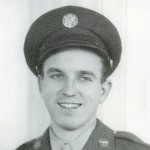
 As I have researched the infantry soldiers of World War II, my thought was that I was really thankful that my dad, Allen Spencer was not one of those men on the ground during the fighting. I felt bad for those men who were on the ground, fighting from the foxholes. I still do, because they were in constant danger. Bombs fall from the sky, and bullets fly from across the battlefield. If those things didn’t kill a soldier, the freezing cold, trench foot, or dysentery from the horribly unsanitary conditions could. It seemed that my dad’s situation was by far safer, but now, I’m not so sure that’s true.
As I have researched the infantry soldiers of World War II, my thought was that I was really thankful that my dad, Allen Spencer was not one of those men on the ground during the fighting. I felt bad for those men who were on the ground, fighting from the foxholes. I still do, because they were in constant danger. Bombs fall from the sky, and bullets fly from across the battlefield. If those things didn’t kill a soldier, the freezing cold, trench foot, or dysentery from the horribly unsanitary conditions could. It seemed that my dad’s situation was by far safer, but now, I’m not so sure that’s true.
The book I had been listening to, that took in World War II from D-Day to The Battle of the Bulge, talked mostly about the ground war, but then at the end, the reader said something that really struck me. It was about the look that crossed the face of a bomber crew’s faces before certain missions…those that would inevitably find the plane flying through flak. The look was one of fear. I knew flak was dangerous, but somehow I didn’t really connect flak with bringing down a plane, or seriously injuring its occupants. Nevertheless, it is quite dangerous for them.
As I researched the dangers of flak, a shocking revelation made itself known. I had written a story about the life expectancy of the ball turret gunner. My findings were that that life expectancy was about 12 seconds. That may be true when one is talking about the prospect of being shot, but when it comes to flak, that cannot be said. Apparently, where flak is concerned, the best place to be is in the plexiglass structure of the ball turret. Plexiglass holds up better against flak than other areas of the plane, so the ball turret gunner is much more protected…at least from flak. The same cannot be said for the bullets flying through the area. I was thankful that my dad was not a ball turret gunner, and that he only filled in as a waist gunner periodically. The waist gunners were in the open, where protection from bullets, and from flak was minimal…at best, non-existent at worst. I can’t imagine how those memories must have affected my dad, but in the book I listened to, the main reason many of the men didn’t want to talk about their experiences in World War II, or any war, was because talking about it brought those memories flooding in again.
After researching flak, and how it works, I can see why the men would get a look of fear on their faces as they prepared to go through areas anti-aircraft weapons shooting flak into the air. Some men said that they could see the red hot glow in the center of the flak, if it was very close. That tells me that it was like a small explosive devise. No wonder it could bring so much damage to a plane. I had known that flak could put holes in the fuselage, but somehow I hadn’t tied that with bringing down a plane. I surmise that it was the B-17 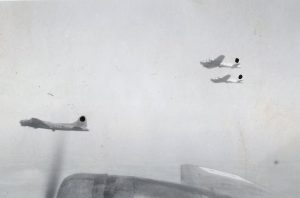
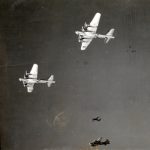 bomber top turret gunner’s daughter in me that wouldn’t allow me to place that danger around my dad. I didn’t want to think about the dangers of his every mission in World War II. My mind seems to have placed his plane in a bubble or a force field, so that no danger could come near him. I think every veteran wonders why they were spared, when others didn’t make it back home. I don’t think anyone can answer that question. As a Christian, I have to credit God for bringing my future dad home.
bomber top turret gunner’s daughter in me that wouldn’t allow me to place that danger around my dad. I didn’t want to think about the dangers of his every mission in World War II. My mind seems to have placed his plane in a bubble or a force field, so that no danger could come near him. I think every veteran wonders why they were spared, when others didn’t make it back home. I don’t think anyone can answer that question. As a Christian, I have to credit God for bringing my future dad home.
 On September 23, 1989, one of the worst days for accidents on the German Autobahn, five huge pileups involving 256 cars with a large number of series injuries, occurred due to heavy fog in the area. The Autobahn in Germany has no speed limits, and cars often travel as fast as 140 miles per hour, which in foggy conditions, is a recipe for disaster. Most of us would think that driving at the speeds seen on the Autobahn would be catastrophic. Here in the United States, where most such highways have a speed limit of 80 miles per hour, travelling at 140 miles per hour would seem more like something you might need a pilot’s license for, rather that a driver’s license.
On September 23, 1989, one of the worst days for accidents on the German Autobahn, five huge pileups involving 256 cars with a large number of series injuries, occurred due to heavy fog in the area. The Autobahn in Germany has no speed limits, and cars often travel as fast as 140 miles per hour, which in foggy conditions, is a recipe for disaster. Most of us would think that driving at the speeds seen on the Autobahn would be catastrophic. Here in the United States, where most such highways have a speed limit of 80 miles per hour, travelling at 140 miles per hour would seem more like something you might need a pilot’s license for, rather that a driver’s license.

Given the speeds on the Autobahn, one might expect it to be one of the most dangerous roads in the world, but their assumption would be very wrong. In reality, the Autobahn is statistically safer than any interstate or other such highway in the world. That seems strange given the speeds seem there. Of course, not all of the Autobahn is speed limit free. The German Autobahnen are widely known for having no federally mandated speed limit for some classes of vehicles, with classes of vehicles being the operative word. There are limits posted, and enforced, in areas that are urbanized, substandard, accident-prone, or under construction. On speed-unrestricted stretches, an advisory speed limit of 81 miles per hour applies. While driving faster is not illegal, as such in the absence of a speed limit, it can cause an increased liability in the case of a collision…which the mandatory auto insurance has to cover. Courts have ruled that an “ideal driver” who is exempt from absolute liability for “inevitable” tort under the law would not exceed the suggested speed limit.

The Autobahn was conceived in the 1920s, and with Hitler’s embrace of the system in 1933, construction was scheduled and began 1936. It was a bold idea to put into motion, and probably the only Hitler back idea that is still in operation today. Of course, Hitler didn’t have many “good” ideas in his lifetime, so this one was an exceptional feat, and obviously not an idea of his making. Nevertheless, the very safe Autobahn continues to be utilized by all of Germany today. It is not accident free, as we have seen by the awful accident of September 23, 1989, but these tragedies seem to be few and far between.

 My nephew, Jason Sawdon, is a decorated patrolman for the Wyoming Highway Patrol. It is a position to be very proud of, and while he would never say that he is proud of himself, because he is not that kind of man, we are all proud of him and his work. Still, it is not his position as a patrolman that has endeared Jason to his family.
My nephew, Jason Sawdon, is a decorated patrolman for the Wyoming Highway Patrol. It is a position to be very proud of, and while he would never say that he is proud of himself, because he is not that kind of man, we are all proud of him and his work. Still, it is not his position as a patrolman that has endeared Jason to his family.
Jason is a wonderful husband to my niece, Jessi and an amazing daddy to their daughter, Adelaide. He has such a soft heart when it comes to his girls, and he would gladly give them the moon…if he could reach it. I love seeing him with his girls, because the love he feels for them is evidenced on his face. There is a look that you see on a man’s face when he has found that his life’s dream is sitting right there beside him. It’s as if he almost can’t believe how very blessed his life has become. Of course, his girls feel the same way about Jason. They know that when God gave them Jason, He gave them the best He had. That’s how a match made in Heaven works. God gives each party the person that is the very best for them.
Jason has a great sense of humor and brings much fun and laughter into their home. And of course, his good nature and that of my niece, have made their little Adelaide into a bit of a comic in her own right, With parents 
 like hers, what else would she be. She has learned from two of the best comics I know.
like hers, what else would she be. She has learned from two of the best comics I know.
All humor aside though, I can honestly say that Jason and Jessi are two people who I feel very blessed to know. They are hard working, talented people, who live life to the fullest. They are involved with their community, and work to make it a better place to live. They aren’t afraid of hard work, and they have made their home a sweet place to raise their family. They love to go camping and hang out with family and friends…especially at the Hadlock place on Casper Mountain. And they love to head back to Michigan to visit Jason’s family there, because family is what it’s all about. Today is Jason’s birthday. Happy birthday Jason!! Have a great day!! We love you!!
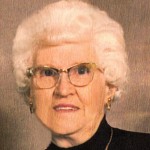
 On July 19, 1989, in the skies over Alta, Iowa, United Airlines Flight 232, on which my great aunt, Gladys Cooper was a passenger, began the fateful journey to a catastrophic end. At 3:16pm, the rear engine’s fan disk broke apart due to a previously undetected metallurgical defect located in a critical area of the titanium-alloy. Basically that meant that the fan disk shattered, sending shrapnel through the hydraulic lines of all three independent hydraulic systems on board the aircraft. This horrific event caused the rapid loss of all the hydraulic fluid. The subsequent catastrophic disintegration of the disk had resulted in a spray of debris with energy levels that exceeded the level of protection provided by design features of the hydraulic systems that operate the DC-10’s flight controls. The flight crew lost its ability to operate nearly all of them. In the resulting crash landing, the right wing just tapped the runway, causing the plane to cartwheel and break apart as it went careening down the runway and into a corn field. While my Great Aunt Gladys was killed in the crash, the skill of the pilot and flight crew saved 185 lives, including their own.
On July 19, 1989, in the skies over Alta, Iowa, United Airlines Flight 232, on which my great aunt, Gladys Cooper was a passenger, began the fateful journey to a catastrophic end. At 3:16pm, the rear engine’s fan disk broke apart due to a previously undetected metallurgical defect located in a critical area of the titanium-alloy. Basically that meant that the fan disk shattered, sending shrapnel through the hydraulic lines of all three independent hydraulic systems on board the aircraft. This horrific event caused the rapid loss of all the hydraulic fluid. The subsequent catastrophic disintegration of the disk had resulted in a spray of debris with energy levels that exceeded the level of protection provided by design features of the hydraulic systems that operate the DC-10’s flight controls. The flight crew lost its ability to operate nearly all of them. In the resulting crash landing, the right wing just tapped the runway, causing the plane to cartwheel and break apart as it went careening down the runway and into a corn field. While my Great Aunt Gladys was killed in the crash, the skill of the pilot and flight crew saved 185 lives, including their own.
While listening to an audio book about World War II, and what happens when bombers flew through flak (Fl(ieger)a(bwehr)k(anone)). I knew that on at least one occasion, my dad, Allen Spencer, a Flight Engineer and Top Turret Gunner on a B-17 in World War II, was tasked with the job of cranking down the landing gear for landing. I don’t know what I had been thinking happened to the landing gear, maybe a close bit of flak the bent something in the gear perhaps, but what had not occurred to me was a catastrophic hit of that flak, causing all hydraulics to be lost. Nevertheless, quite likely that is what happened. It was one of the scenarios discussed in the book. As the hydraulics were lost, the red fluid was all over the floor of the aircraft, and the next thing that was required was to crank down the landing gear, because the gear could not be lowered without hydraulic fluid. Somehow, Dad’s precarious position of hanging out in the open bomb bay doors seemed like such a simple solution to the problem, albeit a heroic act, but the loss of hydraulics could have meant death to the crew. Getting the landing gear down was only part of the problem. What about the flaps, brakes, and such. These planes were in a really bad way.
Of course, my dad’s plane did land safely, given that he became my dad, but years later, when my mother, Collene Spencer’s Aunt Gladys was on a plane crippled by the loss of all hydraulics, I now realize…finally, that when my dad heard about what happened with Flight 232, as we all eventually did, he understood full well, 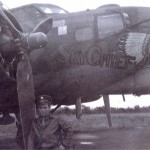
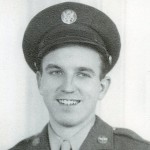 what the flight crew had been faced with. Something I only understood from the view of a spectator…for lack of a better word. He had been there. The Flight 232 situation quite likely took my dad back some 45 years to that day when he had to crank down the landing gear on a B-17 Bomber that had been damaged by flak, probably spilling hydraulic fluid all over the floor where the crew was standing. The experience must have been awful to go through, and the thought of what happened to Flight 232, almost as bad. And yet, in typical World War II veteran style, Dad said nothing, but rather set about comforting his family over the loss.
what the flight crew had been faced with. Something I only understood from the view of a spectator…for lack of a better word. He had been there. The Flight 232 situation quite likely took my dad back some 45 years to that day when he had to crank down the landing gear on a B-17 Bomber that had been damaged by flak, probably spilling hydraulic fluid all over the floor where the crew was standing. The experience must have been awful to go through, and the thought of what happened to Flight 232, almost as bad. And yet, in typical World War II veteran style, Dad said nothing, but rather set about comforting his family over the loss.

